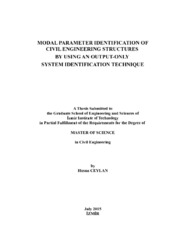Please use this identifier to cite or link to this item:
https://hdl.handle.net/11147/4460| Title: | Modal Parameter Identification of Civil Engineering Structures by Using an Output-Only System Identification Technique |
| Other Titles: | İnşaat Mühendisliği Yapılarının Modal Parametrelerinin Sadece-çıktı Sistem Tanılama Yöntemlerinden Biri Kullanılarak Belirlenmesi |
| Authors: | Ceylan, Hasan |
| Advisors: | Turan, Gürsoy |
| Keywords: | Structural damage Structural change System identification Modal parameter Structural health monitoring |
| Publisher: | Izmir Institute of Technology |
| Source: | Ceylan, H. (2015). Modal parameter identification of civil engineering structures by using an output-only system identification technique. Unpublished master's thesis, İzmir Institute of Technology, İzmir, Turkey |
| Abstract: | Civil engineering structures are designed for a limited lifetime. Due to
environmental effects and degradation of these structures, engineers need to decide on
their structural safety and sustainability from time to time. To this end, structural health
monitoring techniques could be employed to determine the current structural state.
Current conditions of structures could be investigated by system identification
techniques that is based on the modal parameters (modal frequencies, modal damping
ratios and mode shapes) of structures.
In this thesis, output-only system identification of civil structures is studied to
estimate modal parameters of two different types of structures. For this purpose, a
combination of the Natural Excitation Technique (NExT) and the Eigensystem
Realization Algorithm (ERA) is coded within Matlab environment. The first study
consists of a numerical and an experimental phase. In the numerical phase, the
technique is implemented on the mathematical model of a three-story model building. In
the experimental phase, it is implemented on the physical model of this three-story
model building. 10 different scenarios of structural conditions are simulated by means
of changes in story masses of the structure. By using NExT-ERA, the calculated modal
frequencies and mode shapes are in good agreement with the results of the eigenvalue
analysis. Further, the simulated mass change in each scenario is detected by a least
squares approach. Changes in story masses are detected within reasonable errors. In the
second study, a methodology is proposed to acquire measurements of large structures by
using a few sensors, only. These sensors are used in a segmental way to measure the
whole structure. The sensors are grouped and the groups of sensors are shifted on the
model to obtain the response measurements from the whole structure. Then the grouped
response measurements that are obtained at different time frames are transformed into
the equivalent response data as if being acquired at a single time interval. To implement
the methodology, a finite element model of a continuous beam bridge is constructed.
Modal parameters of the model are estimated by using NExT-ERA and the results show
that the first 10 modal frequencies are consistent with those of the eigenvalue analysis
of the model, but only the first 6 mode shapes are successfully identified. İnşaat mühendisliği yapıları sınırlı bir zaman zarfında hizmet verecek şekilde tasarlanmaktadır. Çevrenin yapılar üzerindeki etkisi nedeniyle yapılar zaman zaman güvenlik kontrolünden geçirilme ihtiyacı duyarlar. Yapıların mevcut durumları, yapı sağlığı izleme yöntemleriyle kontrol edilebilmektedir. Günümüzde modal parametrelerin (mod frekansları, modal sönüm oranları ve mod şekilleri) tayinine dayanan sistem tanılama yöntemleriyle yapıların mevcut durumları hakkında bilgi sahibi olunabilmektedir. Sunulan bu tez kapsamında, sadece-çıktı sistem tanılama ile iki farklı inşaat yapısının modal parametrelerinin tayini üzerine çalışılmıştır. Bu amaçla, Doğal Uyarım Tekniği (NExT) ve Özsistem Realizasyonu Algoritması (ERA)'nın bir kombinasyonu Matlab ortamında programlanmıştır. İlk çalışma sayısal ve deneysel çalışma olarak iki kısımdan oluşmaktadır. Sayısal çalışmada yöntem üç katlı bir model binanın matematiksel modeli üzerinde uygulanmıştır. Deneysel çalışmada ise yöntem bu üç katlı binanın fiziksel modeli üzerinde uygulanmıştır. Yapısal değişimleri inceleyebilmek adına, kat kütlelerindeki değişimle 10 farklı yapısal durumun davranış benzetimi yapılmıştır. NExT-ERA kullanılarak hesaplanan mod frekanslarının ve mod şekillerinin modelin özdeğer analizi sonuçlarıyla uyumlu olduğu gözlenmiştir. Yapısal durum tespitinde en küçük kareler yöntemi kullanılmıştır. Tespit edilen kütle değişimleri gerçek değişim değerleriyle yakın sonuçlar vermiştir. İkinci çalışmada, büyük inşaat yapılarının sınırlı sayıda algılayıcı kullanılarak ölçümlerinin yapılabilmesi için bir yöntem önerilmiştir. Algılayıcılar gruplar halinde kullanılarak yapının tüm ölçümü alınabilmiştir. Farklı zaman aralıklarında alınan grup ölçümleri yapının eş zamanlı alınan tek bir ölçümüne dönüştürülmüştür. Uygulama için sürekli kiriş bir köprünün sonlu elemanlar modeli oluşturulmuş, NExT-ERA ile modal parametreleri tahmin edilmiştir. Tahmin edilen ilk 10 modun frekansı modelin özdeğer analiz sonuçlarıyla yakın çıkmıştır. Fakat, modelin sadece ilk 6 mod şekli başarılı bir şekilde tahmin edilebilmiştir. |
| Description: | Thesis (Master)--Izmir Institute of Technology, Civil Engineering, 2015 Full text release delayed at author's request until 2017.08.07 Includes bibliographical references (leaves: 106-108) Text in English; Abstract: Turkish and English xi, 109 leaves |
| URI: | http://hdl.handle.net/11147/4460 |
| Appears in Collections: | Master Degree / Yüksek Lisans Tezleri Sürdürülebilir Yeşil Kampüs Koleksiyonu / Sustainable Green Campus Collection |
Files in This Item:
| File | Description | Size | Format | |
|---|---|---|---|---|
| T001393.pdf | MasterThesis | 8.05 MB | Adobe PDF |  View/Open |
CORE Recommender
Page view(s)
234
checked on Jun 10, 2025
Download(s)
168
checked on Jun 10, 2025
Google ScholarTM
Check
Items in GCRIS Repository are protected by copyright, with all rights reserved, unless otherwise indicated.